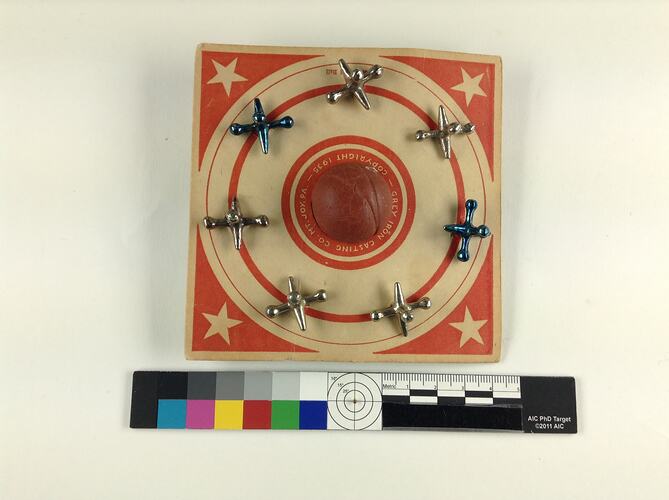Summary
Seven metal jacks attached to a piece of square cardboard with a rubber ball in the centre of the card. Made by Grey Iron Casting Company, Mt Joy, Pennsylvania, USA, in 1935. They were purchased in Maryland, USA in the 1950s for the Dorothy Howard Collection.
Jacks is an ancient game, dating back to prehistoric times. The first jacks were natural materials - animal bones, stones, seeds and shells, and when the game became a popular part of children's culture, manufacturers began mass-producing them from plastic and metal. In Australia, jacks are mostly shaped like sheep's knucklebones, but overseas there are also ceramic cubes and 'star'-shaped metal pieces. These stones are an example of the natural materials used by children to play jacks in the United States in the early 20th century.
This set is part of the Dorothy Howard Collection, gathered by eminent US folklorist and scholar Dr Dorothy Howard, who visited Australia as a Fulbright fellow in 1954-55 to document and research the folklore of Australian children. The Collection primarily contains documents, photographs and objects from Australia and the United States. It is now contained with the Australian Children's Folklore Collection (ACFC), unique in Australia, documenting contemporary children's folklore across Australia and in other countries reaching back to the 1870s. The Collection has a strong component of research material relating to Victoria.
Physical Description
Seven metal jacks attached to a piece of square cardboard with a rubber ball in the centre of the card. The cardboard is red and buff and has a star in each corner. The rubber ball is red. Each jack has six spikes attached and resembles an atom. Two jacks are metallic blue, three are metallic silver and two are metallic bronze, though the colour is worn.
More Information
-
Collection Names
Australian Children's Folklore Collection, Dorothy Howard Collection
-
Collecting Areas
-
Acquisition Information
Cultural Gifts Donation from Dr June Factor, 18 May 1999
-
Acknowledgement
Donated through the Australian Government's Cultural Gifts Program.
-
Date of Pattern
Grey Iron Casting Co., Mount Joy, Pennsylvania, United States of America, 1935
-
Other Association (See Comments)
Dr Dorothy Howard
Purchased in Maryland, USA in the 1950s for the Dorothy Howard Collection - probably by Dorothy Howard herself. She later gave them to the donor, June Factor -
Inscriptions
On card: 'GREY IRON CASTING CO. MT. JOY. PA / COPYRIGHT 1935 / 7 Jacks and Ball'.
-
Classification
-
Category
-
Discipline
-
Type of item
-
overall dimensions
11.5 cm (Length), 3 cm (Width), 11.5 cm (Height)
-
Maximum dimensions
115 mm (Length), 115 mm (Width)
Measurement From Conservation.
-
References
Hope, C. 'Themes From the Playground', Melbourne, 1984, pp53-61. See also Supp File 99.01.
-
Keywords



